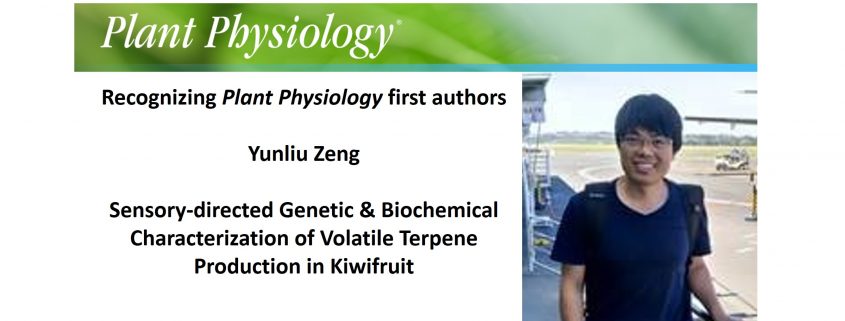Recognizing Plant Physiology authors: Yunliu Zeng
Yunliu Zeng, first author of Sensory-directed Genetic & Biochemical Characterization of Volatile Terpene Production in Kiwifruit
Current Position: Associate Professor at Huazhong Agricultural University (HZAU), China
Education: Ph.D. and Master of Pomology at HZAU, China; BSc of Horticulture in Zhejiang Agricultural & Forestry University, China
Non-scientific Interests: basketball, billiards, ping-pong
Brief bio: While growing up in the countryside, I witnessed the hardship of farmers, so I wanted to do something for China’s agricultural and rural farmers. What I saw and heard in my childhood made me interested in plants, especially horticultural crops, which also made me choose horticulture as my major in university. Subsequently, I chose citrus as the research material to study the mechanism of fruit coloring focusing on the differentiation and regulation of fruit chromoplasts under the supervision of academician Xiuxin Deng. During this period, I was sponsored to work in the Paul Jarvis laboratory of Oxford University working on the import of plastid proteins. After Ph.D. graduation, I continued to work at HZAU focused on flavor regulation in plastids. Since 2017, I focused on studying the mechanism of starch degradation in kiwifruit, and the impact of volatile compounds, especially terpenoid volatiles on kiwifruit flavor and postharvest quality. The data in this paper are from a year’s collaborative research in the Ross Atkinson laboratory at the New Zealand Institute of Plant & Food Research. Nowadays, I am guiding my doctoral and master students to start their research careers and will do my best to expand their knowledge, solve industrial problems, and explain their scientific truth.
猕猴桃是近代驯化最成功的水果之一。猕猴桃因富含VC、钾、镁和叶酸等营养物质及良好的风味受到消费者的青睐。猕猴桃的风味是由挥发性物质释放的香味以及甜味、酸味的微妙平衡所决定,是影响消费者选择的重要因素。不同类型猕猴桃果实具有不同香味体验,如美味猕猴桃呈‘青草’香型,中华猕猴桃呈不同程度的‘果香’和‘花香’香型。猕猴桃果实通常可以检测到30~100种挥发性芳香物质,其中,丁酸甲酯和己酸乙酯(具有‘果香’型),己醛和己烯醛(‘青草香’型)是多数猕猴桃品种果肉中都存在的香气活性物质,而其他挥发性物质,如一些萜类物挥发性物质则只在‘黄金果’、‘红阳’等猕猴桃品种果实中特异积累,呈现浓郁‘花香’香型;因此,黄金果和红阳成为育种家青睐的育种亲本,选育出诸如G3、东红等世界知名新品种。
本研究利用消费者感官评价表明中华猕猴桃‘黄金果’果实因含有较高浓度的单萜物质—桉叶油醇(1,8-cineole)而呈消费者喜欢的‘薄荷’、‘松香’等花香香型。利用具有富含桉叶油醇中华猕猴桃和不含桉叶油醇的美味猕猴桃的F1杂交群体,通过香气物质鉴定和QTL遗传定位关联分析及基因功能验证,结果表明AcTPS1b是决定果实特殊‘薄荷’香味形成的主效基因;进一步研究表明该基因不仅可以产生桉叶油醇,还能形成16种其他单萜,其中桉叶油醇含量占所鉴定单萜的60%左右,这些单萜涵盖了猕猴桃果实中所能释放的绝大多数萜类香气物质。与此同时,我们还鉴定到另外三个同源基因AcTPS1a、AcTPS1c、AcTPS1d,分别产生单萜香桧烯(sabinene)、单萜香叶醇(Geraniol)、二萜springene。此外,我们还发现桉叶油醇的释放跟果实发育期相关,并受乙烯诱导,呈现‘双抛物线’积累模型。总之,本研究为培育富含特殊香味的猕猴桃新种质奠定理论基础,并为提升猕猴桃果实采后风味品质提供指导,具有重要的理论和应用实践意义。
本研究的第一作者是来自华中农业大学园艺林学学院的曾云流副教授,通讯作者是新西兰植物食品研究所(Plant and Food Research, PFR)的Ross Atkinson高级科学家。本项目受到新西兰商务部、PFR、中国国家重点研发计划、华中农业大学和中国留学基金委的资助。




